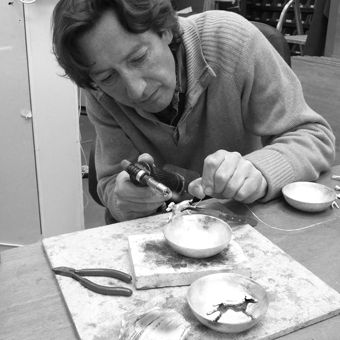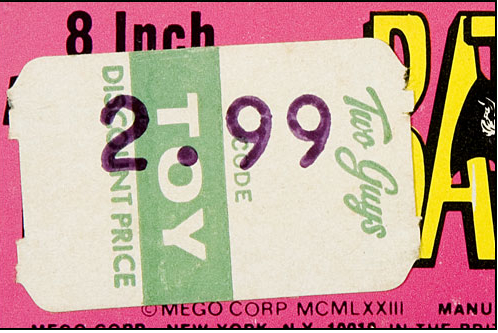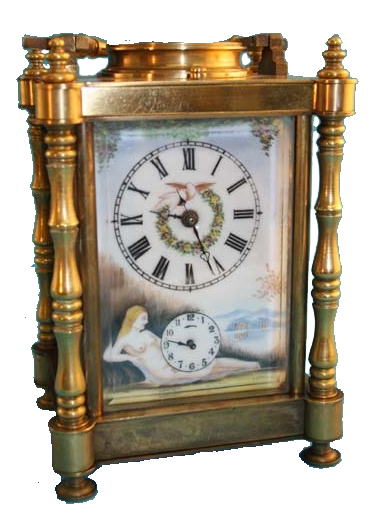Maintaining the surface or patina of sculptures and statues of stone, bronze, spelter or lead, whether kept indoors or outside, is a top priority.
Prudent siting of outdoor sculpture in a sheltered position is the first step to practical conservation. Water dripping from a tree will stain a statue placed beneath, and mould, algae and lichen form more readily on objects exposed to northerly weather. In extreme cold, stonework can split or shatter, as moisture absorbed by the stone expands on freezing. Removing soil from urns and troughs will lessen the danger of frost damage, but it is not practical to wrap an object against frost as moisture becomes trapped. Outdoor pieces can be raised above ground level on plinths with built-in, damp-proof membranes, and should be kept clear of plants such as ivy, and of fallen leaves, both of which can stain and also secrete weak acids that may pit the surface. Cover all items before spraying garden chemicals.
Stone and Marble
Some stone dissolves or is irreparably worn away by misguided attempts at cleaning. Limestone, sandstone and Coade stone form a weathered surface crust, which if removed will expose a vulnerable, crumbly surface beneath. If the surface is smooth and hard you can lightly hose it with water, easing a loosened dirt with a soft-bristled brush. Algae and lichen do little harm, and in most cases add to a statue’s value, but can be removed, if the surface is sound, by brushing with a solution of a teaspoon of dichlorophen (available from a garden shop) to a pint (570ml) of water.
Alabaster and marble are porous and stain easily, and marble discolours and deteriorates , particularly in salty or polluted air. Attempts to remove stains from any porous stone may force the stain deeper or erode the surface. Alabaster and soapstone are very soft, easily in water, so should be dusted regularly to prevent build-up of dirt. However, a sound surface can be wiped (not rubbed) gently with cotton wool barely moistened in a mixture of ½ pint (285ml) each of white spirit and distilled water and one teaspoon of mild or non-ionic detergent. Rinse each section as you go with cotton wool dampened with distilled water. The solution is also suitable for cleaning hardstones such as polished granite, onyx, blue john, jade and agate.
To liven up and protect a cleaned surface of any of the above materials, apply a light coat of microcrystalline wax with a soft-bristled brush and buff gently with a clean white cloth. White marble and similar materials can be dusted with pure talc to fill the pores and prevent dust becoming ingrained.
Plaster is very porous and water-soluble, and should only ever be regularly and gently dusted with a soft-bristled brush.
Major repairs to, or restoration of, stonework should only be done by a specialist, who will use a special resin compound mixed with ground-up stone to match the object. If you want to try mending a minor break yourself, use a quick-setting epoxy resin adhesive.
Bronze, Spelter and Lead
The desirable dark or greenish-brown patina that forms on bronze must be preserved, so do not use metal polish or solvent on any bronze, or even water on indoor bronzes; dusting should suffice. A dull patina can be revived by a very light coating of microcrystalline wax. Test an inconspicuous area first to make sure the patina is stable – an artificially induced or painted one may not be. Apply the wax with a soft-bristled brush and burnish gently with a soft cloth. Archaeological bronzes or items which may have been exposed to salty air may develop ‘bronze disease’-small powdery, green spots on the surface. You can wax a small area immediately, but anything more serious should be taken to a conservator for specialist treatment.
Spelter is softer and more brittle than bronze, and is prone to corrosion about which little can be done. Figures are often thinly cast and fragile, so do hold them at the most solid part. Painted or gilded figures should not be allowed to get wet, but dusted lightly with a soft-haired artist’s brush. Unpainted spelter can be waxed as for bronze, above.
Lead is heavy and very soft, easily dented and scratched and poisonous – so always wash your hands after handling. Corrosion appears as white, powdery coating. Dust indoor lead regularly. A sound surface can be cleaned with a soft-bristled brush or cotton wool moistened in water with a few drops of non-ionic detergent. Rinse and dry well immediately. Microcrystalline wax helps prevent further deterioration: apply one or two coats (leaving an hour between coats) and buff gently with a soft cloth.











